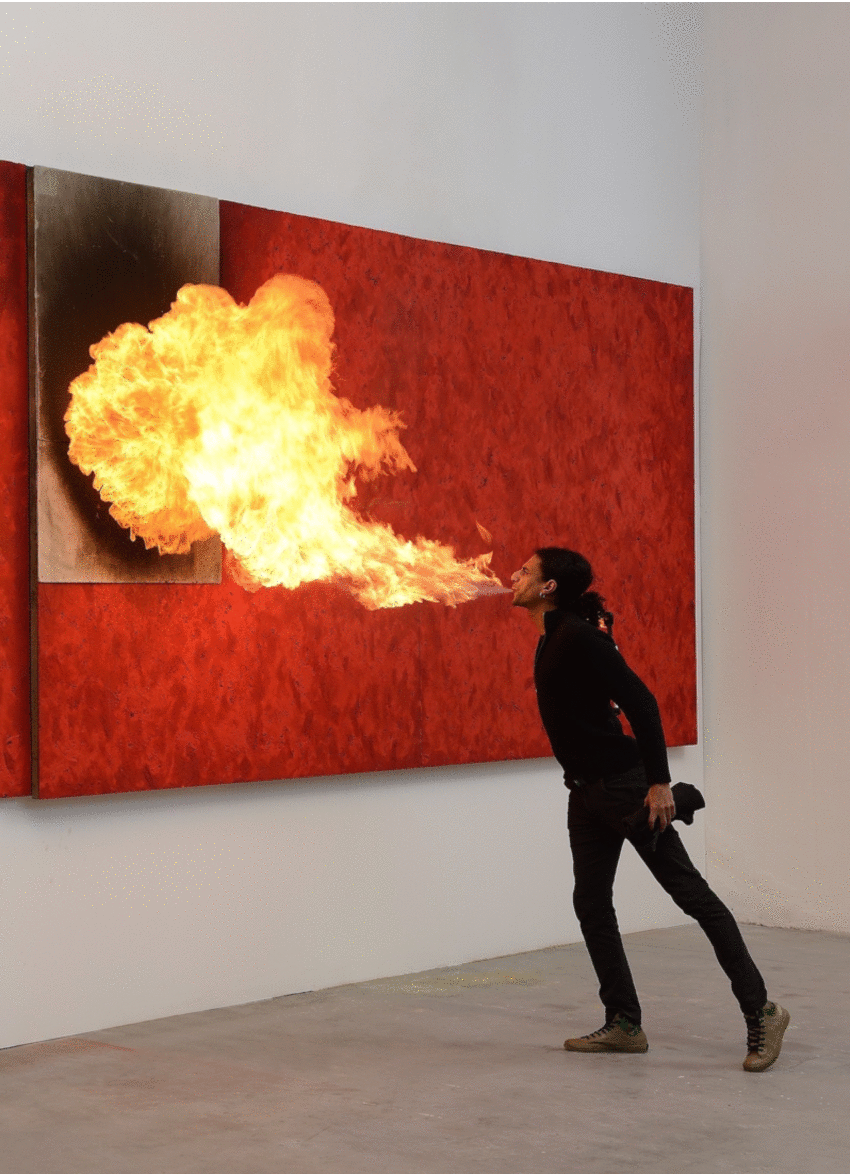Painting as a Butterfly
June 8–September 30, 2019
Standing on Top of a Building: Films 2008-2019
June 22–October 14, 2019
Via Settembrini, 79
80139 Naples
Italy
Hours: Wednesday–Monday 10am–7:30pm
T +39 081 1973 7254
info@madrenapoli.it
Painting as a Butterfly is the first major retrospective dedicated to the pictorial and drawing research of Pier Paolo Calzolari (Bologna, 1943), one of the most important contemporary Italian artists, exponent since the ’60s of the research related to Arte Povera. The exhibition, organized in collaboration with the Fondazione Calzolari and curated by Achille Bonito Oliva and Andrea Viliani, includes over 70 paintings, drawings and multimaterial works created from the mid-’60s to the present. The practice of painting for Calzolari is a “listening instrument,” a state of “suspension” (whose metaphor is the butterfly of the exhibition title) capable of leading to the synthesis the multiple articulations of his artistic research, which is at the same time minimalist and sensual, conceptual and Baroque. Calzolari spent his youth in Venice, where he was influenced by distinctive elements of Venetian painting, such as luminist effects and the reflection of the light on architectural surfaces. Adopting in his works elementary and often organic materials—such as ice, fire, salt, lead, tobacco leaves, moss, burnt wood, walnuts, animal shells, along with neon and felt—Calzolari realized paintings and drawings which represent a characteristic and a fundamental component of his artistic practice, delineating a reflection on the relationships between color, form, object and environment, also in the reference to the experimentations of the 20th century Metafisica and Valori Plastici. In his works Calzolari has retraced and freely compared apparently antithetical elements and concepts such as natural materials and pictorial representation, abstraction and figuration, visual and performative dimension, space-time of the work and the environment in which it is inserted, reshaping it. Exploring also the possible relationship between research lines historiographically reputed as opposed, such as Arte Povera and Transavanguardia, the exhibition becomes a research instrument aimed at delving into Calzolari’s complex and articulated artistic practice, in a critically open relationship with the history of the Italian contemporary art. A fully illustrated monograph will be published by Edizioni Madre (release: summer 2019).
Standing on Top of a Building: Films 2008-2019 is the first retrospective dedicated to the videos and films of Liam Gillick (Aylesbury, UK, 1964), one of the most influential contemporary artist. Curated by Alberto Salvadori and Andrea Viliani, the exhibition examines Gillick’s filmic production in a site-specific staging conceived by the artist specifically for Madre museum. Beginning in the early ’90s, Gillick created works that included installation, sculpture, textual intervention, video, sound and digital animation, all establishing the link to an intense critical and theoretical production. At the heart of Gillick’s artistic practice resides a complex set of issues, strictly related to each other: the relationship with the space and time, not just the physical ones, but the political, social, economic and environmental ones; the centrality of the spectator, as an active agent who produces meaning; the world of communication and the relationship of mutual dependence intercurring between the late-capitalist/neo-liberalist economy, the arts and the institutions. At the Madre for the first time the audience will be able to analyze the most intimate element of Gillick’s artistic research: films conceived in the domestic environment of his apartment in New York, where his ideas form and flow. Compared to his sculptures and installations, a selection of which closes the exhibition, the films are a further elaboration and extension of his research into the role of interpretation as an ongoing task, that is never really finished. The interpretation becomes an instrument of narration, while the language is the most incisive in contemporary hermeneutics. Gillick’s films are the paradigm of intuition, meant as the critical representation of a subject that is contextualized and analyzed, though being absent. The real subjects are often dislocated off-stage—occupying the same position as the spectator—and the artist himself is always present—even if unseen—in his films as their inner subject-object. In the exhibition each room is marked by different interventions responding to each other (posters, wall paintings, and soundtracks that switch between the rooms automatically), drawing not just the path for a visit, but a path of knowledge. An artist book will be published by Edizioni Madre (release: summer 2019).

